Abstract
Current research has ignored the hiddenness and the stochasticity of the evolution of public crisis management research, making the knowledge trajectories still unclear. This paper introduces a combined approach, LDA-HMM, to mine the hidden topics, present the evolutionary trajectories of the topics, and predict the future trends in the coming years to fill the research gaps. We reviewed 8543 articles in WOS from 1997 to 2021, extracted 39 hidden topics from the text using the LDA; 33 remained by manual labeling. The development of the topics over the years verifies that the topics are co-evolving with the public crisis events. The confusion and transition features indicate that most topics are confused or transferred to the others. The transition network and the direction of the topics show that six main transfer paths exist, and in the evolution process, the topics have become more focused. By training the HMM, we predict the trends in the next five years; the results show that the heat of the topic that focuses on traditional crisis issues will decrease while the focus on non-traditional issues will increase. We take the average error to test this model’s prediction effect by comparing it with the other approaches, concluding that it is better than the others. This study has practical implications for preventing crisis events, optimizing related policies, and grasping key research areas in the future.
Keywords:
public crisis management; knowledge trajectories; topic-clustered evolution extraction; latent Dirichlet allocation; hidden Markov model MSC:
68W50
1. Introduction
Emergency prevention and aftereffect eradication [1], usually divided into four stages (prevention, preparedness, response, and recovery) [2], are the core of public crisis management. In reality, public crisis management relies extensively on strategic management [3,4], the legal framework [5], knowledge management systems [6], and information transition [7,8,9]. As a public management behavior, the optimization of relevant public policies is vital and urgent, especially under the economic depression and the COVID-19 pandemic all over the world. However, public crisis management at the micro-level is composed of a series of crisis event preventions and disposals, such as those of natural disasters, emergent public health events, or production safety accidents, which are difficult to identify before the outbreak and have high independence and heterogeneity, making the evolution and the future trend of public crisis management ambiguous and unpredictable.
Public crisis management research: the primary acknowledgment source of public crisis management that co-evolved with the public crisis events. Academic research provides essential knowledge references for policymaking because of its foresight and authority. Evidence from the practice shows that, in a stable regime, the public administrations are prone to allocating more resources to the fields in which public crisis events occur frequently and to making policies to enhance the capability to eliminate the risk factors. It relies heavily on the expert experience to distribute the limited resources more appropriately and efficiently and make the policies more reasonable. Moreover, in reality, most public crisis management experience in public administration originates from previous research on the practice. Hence, there is a co-evolutionary relationship between public crisis management and academic research. Specifically, crisis events change the external environment on the one hand; the external environment can also change the conditions of the crisis events on the other hand. At the same time, the condition and the situation of public crisis management map to the academic realm through the demand and application of the knowledge. These correlations between the public crisis events, public crisis management, and academic research provide an approach to revealing the evolution mechanism of public crisis management.
Text mining and machine learning: the effective and practical strategy to explore the trajectory of public crisis management. The literature review has become quantifiable and visualizable due to advancements in technology. That makes the review of the whole literature on special issues available in social science when, e.g., highlighting the research streams and themes [10], exploring the institution contributions and related subject areas [11], tracing the research trends and hot topics [12], analyzing the co-authoring networks [13], etc. These bibliometric analyses provide essential experiences and paradigms for the knowledge trajectory exploration on public crisis management. However, public crisis events result from the accumulation of risk factors and the brittle addition of hazard-bearing bodies that make the events random. The aforementioned correlations between public crisis management and its research could deliver this randomness into related research. Moreover, the situation of the risk factors and the hazard-bearing bodies is always unobservable, which makes the state of academic research latently either. Therefore, it is crucial to understand how public crisis management research evolves and how will it develop in the future.
Given this, this research aims to extract the hidden topics of public crisis management from the massive text, explore their trajectory, and predict their future trend based on the relevant public policy theories and the features of public crisis management. It refers to the existing research on tracing the evolution of 3D print technology [14] and gives an overview of the thematical evolution of land degradation [15]; it takes text mining and machine learning methods as the primary tools of empirical study. The experimental data are collected from 1997 to 2021 from the Web of Science Core Collection database in order to explore the trajectory of the topic evolution in the time dimension.
The rest of this paper is organized as follows. Section 2 presents the previous works related to the core task of this study and explains the contributions. Section 3 explains the theories, materials, and methods, including the theoretical analysis tools, mathematical models, and the experimental data collection. Section 4 describes the setup and the results of the experiment, using the text mining and machine learning approaches, and analyzes and explains the results. Section 5 summarizes the main contributions and achievements of this study. Section 6 concludes with the limitations of the paper and highlights future work in this area of research.
2. Related Works
This section is divided into four parts. The first part presents the core process of the public crisis and the current research. The second part describes the commonly used bibliometrics approaches and the topic extraction techniques used in recent years. The third part reviews the existing research related to the evolution of public crisis management. The fourth part summarizes the related works and expounds on the contributions of this study.
2.1. Public Crisis
Public crisis management is a comprehensive dynamic management process. As the leading public sector, the government effectively uses public power, integrates public resources, and prevents, handles, and eliminates public crises [16]. Conversely, from the management’s perspective, information communication is a crucial way to deal with public crises because the information in the crisis management process has the characteristics of “secondary dissemination”. After Beck proposed the concept of the risk society, the 9/11 incident made public crisis management more urgent [17]. Moreover, understanding and managing public crises has become a significant issue for public organizations [18]. As for the issues, current research mainly focuses on food safety [6], public health [19,20], ecological emergency [21], public finance [22] and debt [23] crises, economic crises [24], information diffusion [25] in crisis management, leaders [26], leadership [27], and decision-making teams [28] in public crises, etc. Furthermore, the contents, such as public crisis management phases [28], the case studies of public crises [29], and public crisis management capability [30], have been discussed in depth.
2.2. Bibliometrics Approach
Bibliometrics rose in the 1980s. Small et al. [31] proposed a co-citation analysis to reveal the intrinsic relationship between the literature and authors. Dedicated software is the most popular tool for current scholars. This software includes CiteSpace, developed by Chen Chaomei [32]; the BibExcel, developed by Olle Persson [33]; the VOSviewer [34], designed by Van Eck and Waltman [35]; and the Bibliometrix, based on the R-package [36]. These tools offer handy methods for analyzing bibliographic data and constructing and visualizing bibliometric networks. Researchers could come to know the key areas of bibliographic coupling, co-citation, or co-authorship relations. Gephi and SCI2, for example, can also be applied in data preprocessing, network extraction, and visualization based on big data analysis [37].
The Latent Dirichlet Allocation (LDA) model has been applied in bibliometrics for the thematic analysis of massive heterogeneous text data in recent years [15]. Due to its advantages in efficiency and accuracy, the LDA model has been widely used in different disciplines, such as economics [38], information management [39,40], technology management [41], land management [15,42], etc.; mining the topics from multi-dimension massive text data to grasp the knowledge venation holistically is indispensable in the big data era. Moreover, on the benefits of machine learning techniques, their scope is expanding in almost every area of life [43], e.g., for prognostic factor identification using data mining and machine learning techniques [44], challenges overviews [45], and performance comparison [46] for cybersecurity, etc. The machine learning techniques make the text analysis quite efficient [47].
2.3. Public Crisis Research Evolution
Current research on the evolution of public crisis management mainly covers the latest applications of the results [48] and the progress [13], the topic clusters and the distribution [49,50,51], the hotspot evolution trends [12], and the growth in the published literature [11]. The data of these studies mainly include specific countries [13] or the whole world [48,52], as well as document databases [11,12]. Research methods and tools mainly contain keyword co-occurrence analysis and bibliometric coupling analysis [49], relational bibliometrics and keyword networks [50], thematic clusters and the temporal evolution of focus topics [51], and visualization software, such as CiteSpace [53] and VOSviewer and the Online Analysis Platform of literature metrology [12]. A few studies have used machine learning, such as unsupervised text mining, to explore knowledge diffusion [54].
Although the current research forms the theoretical and methodological foundation for the evolution analysis of public crisis management research topics, the deficiencies are outstanding: it pays insufficient attention to the evolution of hidden topics or to the topics closely correlated to the significant public crisis events; bibliometric software could not cluster text according to topic distribution and distinguish the importance of keywords; few methods and tools could reveal the randomness and hiddenness of public crisis management research topics and predict the future trends.
2.4. Contributions
The contributions of this study are:
- It proposes an analysis framework based on punctuated equilibrium theory and introduces a combined approach using text mining and machine learning techniques to describe the evolutionary trajectories of public crisis management research.
- It takes the dataset that contains the articles from 1997 to 2021 to conduct the experiment; it mines 33 topics and presents their evolutionary trajectories, including the development process, confusion and transition features, transition network and direction.
- It predicts the research trend in the next five years, including the dimension of dispersion degree and the hot research issues.
- It evaluates the effectiveness of the LDA-HMM in this study by comparing the average error with the other approaches.
3. Theories, Experiment Design, and Data Collection
The main goal of this study was to depict, analyze, and predict the knowledge trajectories of public crisis research. The first step is to clarify the evolution characteristics of public crisis events and the mechanism of relevant policymaking. Then, the mathematical model is used to describe the evolution process of public crisis management research.
3.1. Public Crisis Management Research from the Punctuated Equilibrium Theory
A public crisis event is the result of the evolution and the fermentation of public risks within a specific environment. However, this specific environment is usually unpredictable due to the co-evolution of a public crisis event and its environment. An uncertain event occurs in an uncertain environment, and they co-evolve with each other, ultimately producing uncertain consequences. Hence, there are two intrinsic motivations for the generation of public crisis events, the accumulation of the risk factors and the changes in the external environment. The former makes the crisis latent, and the latter stochastic.
The essence of public crisis management is to adjust the relationship between the crisis factors and the external environment. To this end, public policy, supported by related research, is the indispensable tool. The “incrementalist” framework dominated theories of policymaking from the 1950s to the 1990s [55]. However, to a certain extent, it is difficult to forecast the policy results [56]. The punctuated equilibrium theory posits that the policy process is not only long-term, progressive, and stable but also short-term, mutated, and unstable [57], which has been verified in the research on long-term state budget trends [58] and national and subnational information processing and policy change [59].
In a certain period, the status of is determined mainly by , not the status before. So, this study uses the HMM to describe the academic research on public crisis management because of the hiddenness and the stochasticity of public crisis and public policy and the correlations between them. Specifically, the process of public crisis management is a hidden Markov process. Moreover, the attributes of this process pass to the academic research by the mapping relations mentioned above.
3.2. Experiment Design
The core of the knowledge evolution analysis is the research heat, confusion, and transition features of the topics and the future research trends, based on the inferring of the topics’ state transition matrix and the probability distribution of the initial state with HMM. Before that, the indispensable step is to extract the topics from the literature texts for the hiddenness of the topics.
3.2.1. Hidden Topic Mining in Public Crisis Management Research
The Latent Dirichlet Allocation (LDA) algorithm is a mixed probability model proposed by Blei et al. in 2002. The LDA seeks word clusters by maximizing the co-occurrence probability of words and it uses Dirichlet Distribution to describe the generation process of the research topics [60]. This model avoids the overfitting and excessive parameters of the PLSI method by limiting the number of document topics, and it can extract hidden topics in documents and cluster the documents efficiently [61]; it is accurate in the mining of the latent text topics. Assume that the topic of public crisis management research follows the Hyperparameter Dirichlet Prior Distribution:
where represents the distribution of literature that studies public risk management in the research topic ; it generates topic term distribution for each research topic ; it generates topic word distribution for each research document , and it generates topic item and lexical item for the -th word item in each document. On this basis, the LDA likelihood model can be described as:
The LDA model can set the number of potential topics of a heterogeneous text and thus can reduce the dimension of the text. However, the number of topics set by the LDA model is not necessarily the best number of topics. To obtain the best number of topics for a text, Blei [62] proposed using Perplexity as the criterion for obtaining the number, but this process can easily lead to several similarities between topics. The Hierarchical Dirichlet Process [61], trained automatically by nonparametric models, is often used to calculate the number of topics. However, in this approach, ensuring the accuracy of the iterations is difficult, and the computational efficiency is too low when analyzing large-volume text.
Considering the generalization ability of the model and the topic extraction effect, the Perplexity-Var [63] method, which considers the confusion degree and the similarity between topics, is used to calculate the optimal number of topics. This method measures the stability of the topic structure through the divergence () of the topics and limits excessive topics in order to minimize the number of topics while ensuring a maximum distinction. Moreover, using Heinrich’s parameter estimation method, setting , , and Gibbs sampling, the topic set is , and the topic attribution set of each literature text is .
3.2.2. Topic Evolvement Analysis Based on Double Stochastics
This study uses HMM to describe the evolution process of public crisis management research. By inferring the probability distribution of the state transition matrix and the initial state in HMM, the confusion and transition matrices between the topics in evolution are calculated, and then, the evolution trajectory and the future evolution trend are clarified. The HMM of this study is as follows:
(1) The random transfer sequence set of the hidden state of the topics is:, where is the number of topics calculated using the LDA model. The hidden state sequence generated through the random process is denoted as , where .
(2) In public crisis management research, the probability distribution of the literature research topics transfer from to is , where , , and , .
(3) When the state of the research topic is , the probability distribution of the observation variable is , where is the -th observed random variable, and the observed sequence is . The observation sequence in this study is the proportion of each research topic over the years.
(4) The probability distribution of the initial state is , . In general, if the frequency of co-occurrence of the topic words among the research topics is high, then the relationship between the topics is close, making the mutual migration and co-evolution of the research topics easier. Therefore, the normalized matrix of the co-occurrence numbers of the topic words is used as the initial iteration value of in this article.
(5) The initial value of the HMM training is set as . The Baum–Welch algorithm [28] is used to estimate the parameters of the HMM, and the single optimal state sequence is calculated. In addition, the research topic structure after years is obtained according to the formula .
3.3. Experimental Data Collection
Take the data in the Web of Science Core Collection as the experimental sample. Search the strings “(the) public crisis management” or “management of public crisis” or “public crisis administration” or “public emergency management” or “public risk management” or “the control over the public crisis” in the database on 23 February 2022; there are 8543 articles from 1997 to 2021. Figure 1 shows the number of published articles over the year.

Figure 1.
Articles published over the year.
The average annual growth rate of the number of published articles is about 21%, which is generally stable and suitable for diachronic topical evolution analysis. Moreover, the number increased significantly in 2014 and 2020, and it proved to be related to the Ebola epidemic and the COVID-19 pandemic through the literature cluster. That suggests that the public health incident is critical for public crisis management academic research because of the enormous damage; thus, public health emergency management is the crucial domain of public crisis management. Furthermore, it again verifies that academic research is closely related to public crisis management.
4. Experiments and Results
We deployed the combined model, LDA-HMM, to conduct the hidden topics extraction and the evolutionary feature exploration and tested the validity of this model by comparing it with the other approaches.
4.1. Mining the Hidden Topics of Public Crisis Management
We set the iteration time of LDA to calculate the topic number and mined the topics from the literature text, removed the meaningless topics, and labeled the topics.
4.1.1. Keywords of the Topics
Given that the machine learning effect of the algorithm in LDA is closely related to the iteration times [64], for the maximum effect it is essential to calculate the iteration times before the keywords cluster. In this study, the model converges rapidly as the iteration times increase, and it begins to stabilize after 200 (Figure 2). That is, the best iteration time is 400.
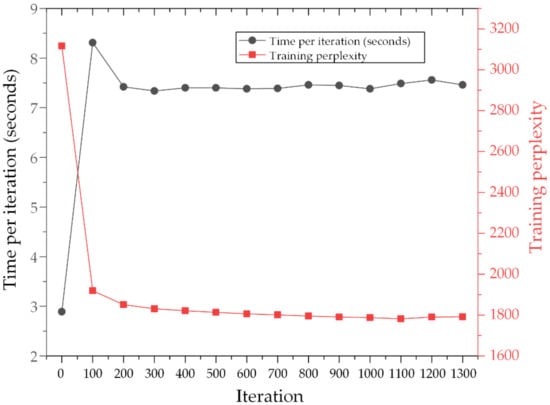
Figure 2.
Effect of iteration times on machine learning.
Set the iteration time to 400 and calculate the optimal topic number according to the Perplexity-Var. Figure 3 shows the Perplexity-Var of the topic number change from 22 to 42; it shows that the Perplexity-Var is smallest if the topic number is 39; hence, the optimal topic number of the text is 39. Using the LDA library in Python to extract topic keywords from the dataset, each topic’s top 400 topic keywords are exported and sorted according to their significance in the topic. After the first extraction, delete the 100 meaningless words, such as “due”, “low”, “well”, and “test” and the numbers including “2009” and “2020”, in total to guarantee the recognition accuracy. Then, repeat the previous step to produce the keywords dataset. By cleaning the keywords artificially, delete the topics unrelated to public crisis management, those composed of function words, and 33 topics remain.
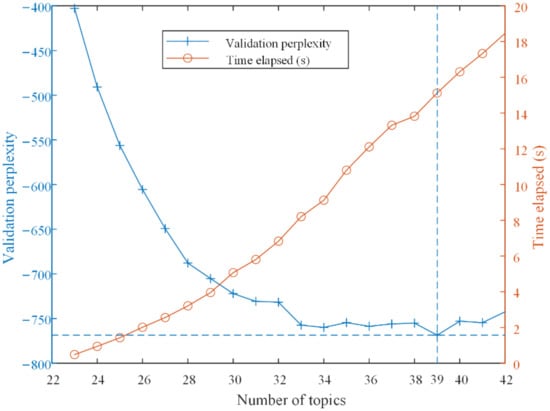
Figure 3.
Perplexity-Var values of different topic numbers.
4.1.2. Topic Naming
By manual labeling, the topic name and the top five keywords are in Table 1.

Table 1.
The top five keywords and topic name.
Taking 10% of the articles on each topic to test the accuracy of the keywords cluster. Figure 4 shows the results, where the topic of highest accuracy is T2 (99.42%), the lowest is T15 (91.22%), and the average accuracy is 95.12%, indicating that the LDA has good credibility in this study.
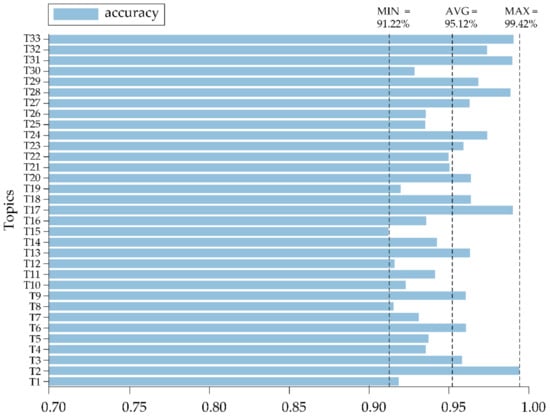
Figure 4.
Accuracy of topics classification.
4.2. Evolutionary Trajectories of the Topics
We described the topic evolution trajectories by calculating the number of published articles and the percentage of topic keywords per year; we explored the transition and confusion trajectories of the topics by estimating the confusion matrix and transition matrix and presented the transition network and transition direction by calculating the transition probability.
4.2.1. Development of the Topics
Here, we draw the heat map of the article number (Figure 5) and the heat map of the percentage of the keywords (Figure 6) over the year based on the topics mined above.
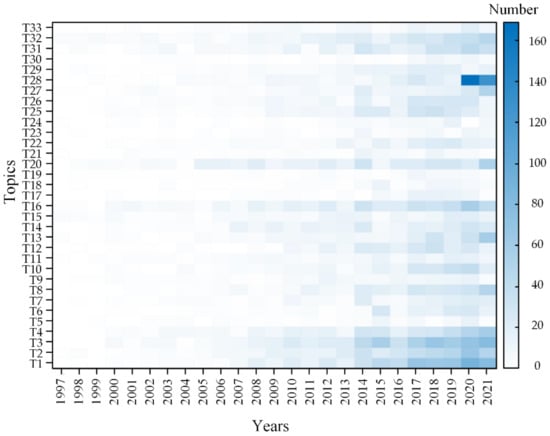
Figure 5.
Heat map of published articles over the year.
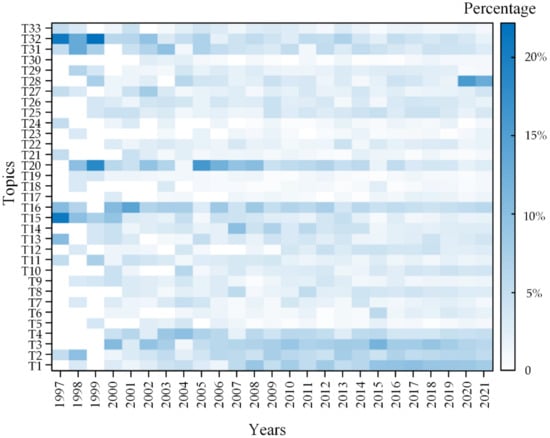
Figure 6.
Heat map of the keywords over the year.
Figure 5 shows that the annual number of articles has remained above 100, and the research topics have gradually increased since 2005. Figure 6 shows that the earliest research topics (1997, 23 papers) are T2, T11, T13, T15, T16, T21, T24, T27, T31, T32, and T33, among which T15 and T32 are the most popular topics. Before 2000, the research topics mainly focused on the areas related to public health and public health management, such as emergency medical treatment, public health emergency response, community healthcare service, and the emergency decision-making model. The hierarchy between the number of published papers and the percentage of keywords in the hot areas based on the statistics tends to be unclear. However, T28 is quite significant in 2020 and 2021; it is closely related to the COVID-19 pandemic.
First, from the topic aspect, T1, T2, T3, and T4 have been continuously of concern in recent years. Even though the contents of these topics are changing, the research heat has not diminished, indicating that these four topics are vital contents of public crisis management research. Second, the research heats of T32, T31, T20, T16, and T15 show an evident downward trend. The decrease in these topics may be relevant to the improvement of internet technology and its application in crisis management, considering that these topics are common to both public health and medical technology. Third, some topics, such as financial crisis, economic crisis, food safety, and climate change, have shown a continuous high heat. This case indicates that the risks in these fields have long plagued human society, but these risks are less likely to trigger significant crises.
4.2.2. Confusion and Transition Features
If there are co-occurrence keywords between two topics, they will confuse or transfer with each other during the evolution process. This study trains the HMM to estimate the confusion and transition matrix of the co-occurrence keywords to analyze the confusion and transfer relationship of the topics (Figure 7).
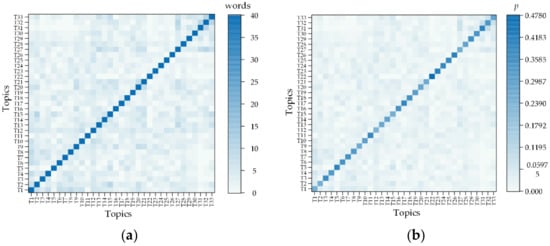
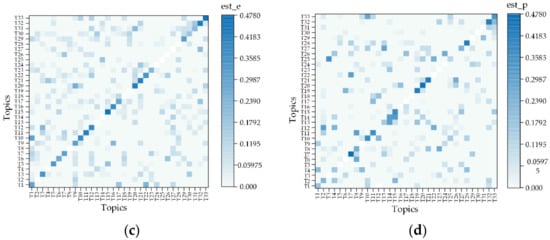
Figure 7.
HMM training process. (a) Keywords co-occurrence matrix; (b) Initial confusion/transition matrix; (c) Confusion matrix estimated by HMM; (d) Transition matrix estimated by HMM.
The keyword co-occurrence analysis method, which counts the common keywords of the topics, is used to measure their similarity. We draw the co-occurrence heat map of keywords, as shown in Figure 7a. The keyword co-occurrence analysis method, which counts the common keywords of the topics, is used to measure their similarity. We draw the co-occurrence heat map of keywords, as shown in Figure 7a. As every topic has all the keywords in common with itself, the diagonal line in Figure 7a has the darkest color; the other areas show different shades of color. The probability in the confusion matrix is used to measure the threshold of mutual migration among different topics in the evolution of public crisis management research for a single topic, which is the possibility of changes in a topic’s direction. The normalized keywords co-occurrence matrix is used for the initial confusion and transfer matrices of the HMM (Figure 7b) and imported into the topic evolution HMM. The HMM is trained through the Baum–Welch algorithm to calculate the optimal confusion matrix (Figure 7c) and transfer matrix (Figure 7d).
4.2.3. Transition Network of the Topics
Figure 8 shows the transition network of the topics with the transition probabilities exceeding 10% (31 in total, except innovation in social governance and pandemic disease control). The node represents the topic, the arrow indicates the transfer direction, and the arrow width shows the transfer possibility. The main paths are: a. organizational relationship → public crisis communication → economic crisis; b. emergency department → emergency medical treatment → emergency clinical cost → public health emergency response → national management program → community healthcare service; c. situation control → emergency decision-making model; d. crisis research approach and application → flood hazard → climate change; e. nuclear safety → district facility management → public crisis cooperate management; and f. financial crisis → disaster response.
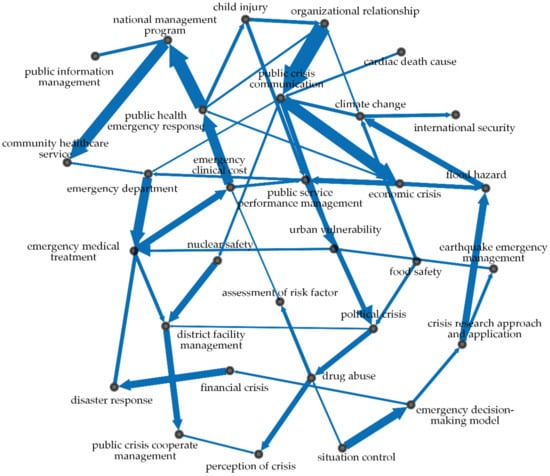
Figure 8.
Transfer network of the topics.
4.2.4. Transition Direction of the Topics
Figure 9 presents the transition direction in which the probability greater than 10% was estimated by HMM. Thirty-one topics (except drug abuse and community healthcare service) transferred to 30 topics, excluding drug abuse, situation control, and earthquake emergency management. It indicates that drug abuse is a relatively independent research topic; so, it cannot be confused with other topics easily. The transfer probability of topic situation control and earthquake emergency management is less than 10% after the confusion, whereas community healthcare service is greater than 10%.
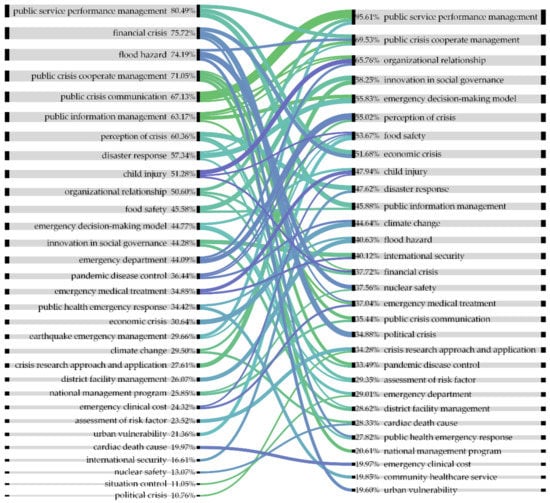
Figure 9.
Transition probability estimated by HMM.
The probability of public service performance management, public crisis corporate management, perception of crisis, and organizational relationship transferring is always greater than 50%. Public service performance management has the most significant probability of transferring into another topic. Public crisis communication is easy to transfer into public service performance management; the potential observation sequence may be a vital content or a way for public crisis communication to become public service performance management in public crisis management. A similar relationship may exist between the financial crisis and the political crises. In reality, the government financial crisis in the domestic aspect could transform into economic and political crises in the international aspect, which is in line with the actual situation in the recent period.
4.3. Future Trends of Public Crisis Management Research
Taking the data of 2020 and 2021 as the base period, we import the parameters of the confusion and transition matrices into the HMM module of Matlab to predict the evolution of the public crisis management research topics from 2021 to 2025. Figure 10 shows the results.
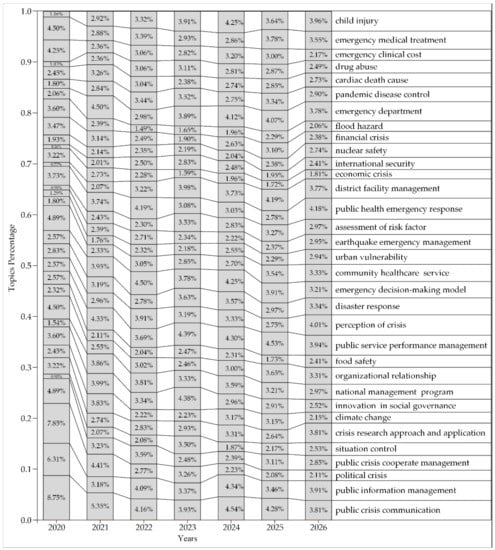
Figure 10.
Prediction of the topics evolution.
The dispersion degree of research heat will decrease (the S.D. for the topic percentage in 2020 is 0.0196; in 2026, it is 0.0068). In 2026, there will be 13 topics whose research heat will increase more than 50%. The increase in the research heat on international security may be related to international relations reconstruction, especially major power relations. The increase in research heat on the topic assessment of risk factors, the national management program, the emergency department, the perception of crisis, and the public service performance management may be owing to the acceleration of human social risk evolution, emergency department establishment, management plans optimization, and crisis awareness, as well as crisis control capabilities enhancement. For this, improving the performance of public services is inevitable. Simultaneously, the social population density in the post-industrial era will become an essential condition for the public crisis events, and cities will become the core object of public risk management. Therefore, the heat of urban vulnerability, district facility management, drug abuse, and child injury will increase. In addition, the increase in the heat on disease control is undoubtedly attributable to COVID-19.
The decrease in political and public crisis cooperation management is probably because of globalization’s continuous advancement [41]. The management of public crisis under the multilateralism framework will move towards cooperation, and the impact of the political crisis will be weak [65,66]. The decrease in public crisis communication and public information management may be owing to the rapid development of science and technology, particularly information technology [8,67,68]. With the progress of science and technology and the improvement of the ecological environment, people’s ability to respond to flood hazards will improve, and the research heat will decrease. With the recovery of the world economy after COVID-19, the research heat of financial and economic crises will decrease. The attention reduction by academia on community healthcare service and emergency clinical cost may be due to the general improvement of social welfare. In addition, the future trend shows that innovation in social governance is a stable topic. Moreover, the decrease in research heat of more than 30% may be related to improved social governance or the increased published articles on other topics which lead to the research heat weakening relatively. In general, the heat of the topic that focuses on traditional crisis issues will decrease while the focus on non-traditional crisis issues will increase.
4.4. Validity Comparison between LDA-HMM and Other Approaches
To evaluate the effectiveness of the LDA-HMM in this study, we use the literature data obtained in Section 3.3, take the IPC classification and the Grey Forecast Model (GM) as an alternative method to predict the evolution trend, and compare the results. Specifically, IPC is an alternative to LDA, and GM is an alternative to HMM. There are four combination methods: LDA-HMM, LDA-GM, IPC-HMM, and IPC-GM. Table 2 shows the results by comparing the average error between the predicted and actual values of the proportion of each topic in 2021. LDA-HMM has the minimum average error; in other words, it has better validity.

Table 2.
Average error of each method.
5. Conclusions
This study introduces LDA-HMM to reveal the knowledge evolution process of public crisis management research and to predict its future trend based on the double stochastics of the research topics. This combined model overcomes some of the shortcomings of the existing bibliometric tools, implements personalized customization for text clusters according to the distribution of the keywords, and judges the importance of the keywords.
This model mined 39 topics of public crisis management from 8543 articles in the Web of Science Core Collection over 25 years and reserved 33 good topics by manual labeling. The heat of the topics, measured by the article number and the keywords number, verifies that the research topic is co-evolutionary with the public crisis events; this is one of the basic assumptions of this study. Further analysis of the confusion and transition relationship of the topics by training the HMM shows that most of the topics are confused or transferred with the others in the evolution process. The transition network of the topics shows that six main transfer paths exist in the evolution process; the transition probability indicates that the topics have become more focused (31 topics whose transition probability is greater than 10% transferred into 30). The confusion or transition probability and direction reflects its stability and openness. In the next few years, the heat of the topic that focuses on traditional crisis issues will decrease while the focus on non-traditional issues will increase. The validity comparison between LDA-HMM and LDA-GM, IPC-HMM, and IPC-GM verified the validity of LDA-HMM in this study.
6. Limitations and Future Work
The main limitation of this study is that the experimental data are limited to the articles for homogeneity, which cannot depict the whole trajectory of the knowledge evolution. Topic labeling relies on manual naming, which heavily depends on the expert’s experience, and it is hard to avoid systematic deviation. Follow-up studies will try to expand the data source and enhance the accuracy of the topic labeling.
Author Contributions
W.X., F.W. and C.L. conceptualized the research and performed the validation. Y.Z., F.W. and C.L. administered the project, developed the methodology, curated the data, conducted the formal analysis, produced visualizations, and wrote and prepared the original draft manuscript. F.W., C.L. and Y.Z. reviewed and edited the manuscript. W.X. acquired funding. All the authors contributed to drafting the manuscript. All authors have read and agreed to the published version of the manuscript.
Funding
This research was funded by the National Natural Science Foundation of China, grant number: 72104064.
Institutional Review Board Statement
Not applicable.
Informed Consent Statement
Not applicable.
Data Availability Statement
All the data can be downloaded at https://www.webofscience.com/wos/alldb/basic-search, accessed on 23 February 2022.
Conflicts of Interest
The authors declare no conflict of interest.
References
- Kosyachenko, S.A.; Kuznetsov, N.A.; Kul’ba, V.V.; Shelkov, A.B. Emergency Management: Models, Methods, and Automation. In Automation and Remote Control; MAIK NAUKA/INTERPERIODICA/SPRINGER: Moscow, Russia, 1998; pp. 765–806. [Google Scholar]
- Tian, J.-H.; Ma, Y.-Y. Establishing Performance Evaluation System of Public Crisis Emergency Management Based on AHP. In Proceedings of the 6th International Conference on Public Administration, Canberra, Australia, 22 October 2010. [Google Scholar]
- Choi, S.O. Emergency management: Implications from a strategic management perspective. J. Homel. Secur. Emerg. Manag. 2008, 5, 127–144. [Google Scholar] [CrossRef]
- Kong, F.; Sun, S. Understanding and Strengthening the Emergency Management and Comprehensive Disaster Reduction in China’s Rural Areas: Lessons from Coping with the COVID-19 Epidemic. Sustainability 2021, 13, 3642. [Google Scholar] [CrossRef]
- Wilson, L.R.; McCreight, R. Public Emergency Laws & Regulations: Understanding Constraints & Opportunities. J. Homel. Secur. Emerg. Manag. 2012, 9, 1–16. [Google Scholar] [CrossRef]
- Yates, D.; Paquette, S. Emergency knowledge management and social media technologies: A case study of the 2010 Haitian earthquake. Int. J. Inf. Manag. 2011, 31, 6–13. [Google Scholar] [CrossRef]
- Huggins, T.J.; Prasanna, R. Information Technologies Supporting Emergency Management Controllers in New Zealand. Sustainability 2020, 12, 3716. [Google Scholar] [CrossRef]
- Mitcham, D.; Taylor, M.; Harris, C. Utilizing Social Media for Information Dispersal during Local Disasters: The Communication Hub Framework for Local Emergency Management. Int. J. Environ. Res. Public Health 2021, 18, 10784. [Google Scholar] [CrossRef]
- Wania, A.; Joubert-Boitat, I.; Dottori, F.; Kalas, M.; Salamon, P. Increasing Timeliness of Satellite-Based Flood Mapping Using Early Warning Systems in the Copernicus Emergency Management Service. Remote Sens. 2021, 13, 2114. [Google Scholar] [CrossRef]
- Nasir, A.; Shaukat, K.; Hameed, I.A.; Luo, S.; Alam, T.M.; Iqbal, F. A Bibliometric Analysis of Corona Pandemic in Social Sciences: A Review of Influential Aspects and Conceptual Structure. IEEE Access 2020, 8, 133377–133402. [Google Scholar] [CrossRef]
- Sweileh, W.M. A bibliometric analysis of health-related literature on natural disasters from 1900 to 2017. Health Res. Policy Syst. 2019, 17, 18. [Google Scholar] [CrossRef] [Green Version]
- Jia, T.Y.; Luo, C.; Wang, S.; Wang, Z.; Lu, X.; Yang, Q.; Zhu, C. Emerging Trends and Hot Topics in Cardiopulmonary Resuscitation Research: A Bibliometric Analysis from 2010 to 2019. Med. Sci. Monit. 2020, 26, 14. [Google Scholar] [CrossRef] [PubMed]
- Sachini, E.; Sioumalas-Christodoulou, K.; Chrysomallidis, C.; Siganos, G.; Bouras, N.; Karampekios, N. COVID-19 enabled co-authoring networks: A country-case analysis. Scientometrics 2021, 126, 5225–5244. [Google Scholar] [CrossRef] [PubMed]
- Wei, C.; Chaoran, L.; Chuanyun, L.; Lingkai, K.; Zaoli, Y. Tracing the Evolution of 3D Printing Technology in China Using LDA-Based Patent Abstract Mining. IEEE Trans. Eng. Manag. 2020, 37, 732–741. [Google Scholar] [CrossRef]
- Lu, X.; Zhang, Y.; Lin, C.; Wu, F. Evolutionary Overview and Prediction of Themes in the Field of Land Degradation. Land 2021, 10, 241. [Google Scholar] [CrossRef]
- Fink, S. Crisis Communications: The Definitive Guide to Managing the Message; Business Expert Press: Hampton, NJ, USA, 2013. [Google Scholar]
- Rosenthal, U. September 11: Public Administration and the Study of Crises and Crisis Management. Adm. Soc. 2003, 35, 129–143. [Google Scholar] [CrossRef]
- Kersten, A. Crisis as usual: Organizational dysfunction and public relations. Public Relat. Rev. 2005, 31, 544–549. [Google Scholar] [CrossRef]
- Avery, E.J.; Park, S. The influences of relationship quality with external partners and required levels of approval of messaging on crisis preparedness. Public Relat. Rev. 2018, 45, 119–127. [Google Scholar] [CrossRef]
- Rodrigo, T.; Caylà, J. Public health crises: The development of a consensus document on their management in Spain. Eur. Commun. Dis. Bull. 2011, 16, 19841. [Google Scholar] [CrossRef]
- Guimont, C.; Petitimbert, R.; Villalba, B. The crisis of biodiversity in the test of neoliberal public action Introduction to the dossier theme “Loss of biodiversity, New Public Management and neoliberalism”. Dev. Durable Territ. 2018, 9, 14. [Google Scholar] [CrossRef] [Green Version]
- Ostrovska, O.A. Innovative Instruments for Crisis Financial Management of Public Enterprises. Actual Probl. Econ. 2011, 123, 154–163. [Google Scholar]
- Zigman, A.; Sverko, I. Institutional Framework for Public Debt Management in the Eu—With the Special Focus on Croatian Case. J. Polytech. Rij. 2017, 5, 33–44. [Google Scholar] [CrossRef] [Green Version]
- Lopez-Casasnovas, G.; Miret, I.P. The Economic Crisis And Its Impact on Public Services Management. Rev. Catalana Dret. Public 2018, 56, 39–55. [Google Scholar] [CrossRef]
- Broekema, W.; Porth, J.; Steen, T.; Torenvlied, R. Public leader’s organizational learning orientations in the wake of a crisis and the role of public service motivation. Saf. Sci. 2019, 113, 200–209. [Google Scholar] [CrossRef]
- Kapucu, N.; Ustun, Y. Collaborative Crisis Management and Leadership in the Public Sector. Int. J. Public Adm. 2018, 41, 548–561. [Google Scholar] [CrossRef]
- Tokakis, V.; Polychroniou, P.; Boustras, G. Managing conflict in the public sector during crises: The impact on crisis management team effectiveness. Int. J. Emerg. Manag. 2018, 14, 152–166. [Google Scholar] [CrossRef]
- Tokakis, V.; Polychroniou, P.; Boustras, G. Crisis management in public administration: The three phases model for safety incidents. Saf. Sci. 2019, 113, 37–43. [Google Scholar] [CrossRef]
- Kim, S.; Krishna, A. Bridging strategy versus buffering strategy: Enhancing crisis management capability in public management for relational and reputational improvement, and conflict avoidance. Asian J. Commun. 2017, 27, 517–535. [Google Scholar] [CrossRef]
- Gervas, J.; Hernandez-Aguado, I.; Grupo Jornada Situaciones de Crisis. Successes and failures in the management of public health crisis in Spain. Gac. Sanit. 2009, 23, 67–71. [Google Scholar] [CrossRef] [PubMed] [Green Version]
- Small, H. Co-citation Context Analysis and the Structure of Paradigms. J. Doc. 1980, 36, 183–196. [Google Scholar] [CrossRef]
- Pan, X.L.; Cui, M.; Yu, X.T.; Hua, W.N. How is CiteSpace used and cited in the literature? An analysis of the articles published in English and Chinese core journals. In Proceedings of the 16th International Conference on Scientometrics & Informetrics (ISSI 2017), Wuhan, China, 16–20 October 2017; pp. 158–165. [Google Scholar]
- Persson, O.; Danell, R.; Schneider, J.W. How to use Bibexcel for various types of bibliometric analysis. In Celebrating Scholarly Communication Studies a Festschrift for Olle Persson at His Birthday; Umea University: Umea, Sweden, 2009. [Google Scholar]
- Tavana, M.; Shaabani, A.; Vanani, I.R.; Gangadhari, R.K. A Review of Digital Transformation on Supply Chain Process Management Using Text Mining. Processes 2022, 10, 842. [Google Scholar] [CrossRef]
- Van Eck, N.J.; Waltman, L. Software survey: VOSviewer, a computer program for bibliometric mapping. Scientometrics 2010, 84, 523–538. [Google Scholar] [CrossRef] [Green Version]
- Nasir, A.; Shaukat, K.; Khan, K.I.; Hameed, I.A.; Alam, T.M.; Luo, S. What is Core and What Future Holds for Blockchain Technologies and Cryptocurrencies: A Bibliometric Analysis. IEEE Access 2021, 9, 989–1004. [Google Scholar] [CrossRef]
- Yang, J.; Cheng, C.X.; Shen, S.; Yang, S.L. Comparison of Complex Network Analysis Software: Citespace, SCI2 and Gephi. In Proceedings of the 2017 IEEE 2nd International Conference on Big Data Analysis (ICBDA), Beijing, China, 10–12 March 2017; pp. 174–177. [Google Scholar]
- Martin, J.C.; Pagliara, F.; Román, C. The Research Topics on E-Grocery: Trends and Existing Gaps. Sustainability 2019, 11, 321. [Google Scholar] [CrossRef] [Green Version]
- Zambrano, P.; Torres, J.; Tello-Oquendo, L.; Jacome, R.; Benalcazar, M.E.; Andrade, R.; Fuertes, W. Technical Mapping of the Grooming Anatomy Using Machine Learning Paradigms: An Information Security Approach. IEEE Access 2019, 7, 142129–142146. [Google Scholar] [CrossRef]
- Lamba, M.; Madhusudhan, M. Mapping of topics in DESIDOC Journal of Library and Information Technology, India: A study. Scientometrics 2019, 120, 477–505. [Google Scholar] [CrossRef]
- Ma, Y.H.; Kong, L.; Lin, C.; Yang, X. Research on the identification of generic technology of eco-friendly materials based on text mining. Environ. Sci. Pollut. Res. 2022, 29, 35269–35283. [Google Scholar] [CrossRef] [PubMed]
- Lu, X.H.; Zhang, Y.; Lin, C.; Wu, F. Analysis and comprehensive evaluation of sustainable land use in China: Based on sustainable development goals framework. J. Clean. Prod. 2021, 310, 127205. [Google Scholar] [CrossRef]
- Dar, K.S.; Luo, S.H.; Chen, S.; Liu, D.X. Cyber Threat Detection Using Machine Learning Techniques: A Performance Evaluation Perspective. In Proceedings of the IEEE International Conference on Cyber Warfare and Security, Islamabad, Pakistan, 31 March–2 April 2020. [Google Scholar]
- Alam, T.M.; Shaukat, K.; Hameed, I.A.; Khan, W.A.; Sarwar, M.U.; Iqbal, F.; Luo, S. A novel framework for prognostic factors identification of malignant mesothelioma through association rule mining. Biomed. Signal Process. Control. 2021, 68, 102726. [Google Scholar] [CrossRef]
- Shaukat, K.; Luo, S.; Varadharajan, V.; Hameed, I.A.; Xu, M. A Survey on Machine Learning Techniques for Cyber Security in the Last Decade. IEEE Access 2020, 8, 222310–222354. [Google Scholar] [CrossRef]
- Shaukat, K.; Luo, S.; Varadharajan, V.; Hameed, I.A.; Chen, S.; Liu, D.; Li, J. Performance Comparison and Current Challenges of Using Machine Learning Techniques in Cybersecurity. Energies 2020, 13, 2509. [Google Scholar] [CrossRef]
- Abdelaziz, A.; Santos, V.; Dias, M.S. Machine Learning Techniques in the Energy Consumption of Buildings: A Systematic Literature Review Using Text Mining and Bibliometric Analysis. Energies 2021, 14, 7810. [Google Scholar] [CrossRef]
- Yang, F.; Zhang, S.; Wang, Q.; Zhang, Q.; Han, J.; Wang, L.; Wu, X.; Xue, F. Analysis of the global situation of COVID-19 research based on bibliometrics. Health Inf. Sci. Syst. 2020, 8, 10. [Google Scholar] [CrossRef]
- Andersen, N.; Bramness, J.G.; Lund, I.O. The emerging COVID-19 research: Dynamic and regularly updated science maps and analyses. BMC Med. Inform. Decis. Mak. 2020, 20, 7. [Google Scholar] [CrossRef] [PubMed]
- Azevedo, N.T.; Junckes, I.J.; Silva, E.A. Development and environmental sciences: Analysing thematic networks of the research agenda in Brazil. Desenvolv. E Meio Ambiente 2021, 56, 158–182. [Google Scholar] [CrossRef]
- Goerlandt, F.; Li, J.; Reniers, G. The Landscape of Risk Communication Research: A Scientometric Analysis. Int. J. Environ. Res. Public Health 2020, 17, 3255. [Google Scholar] [CrossRef]
- Zhang, L.; Zhao, W.; Sun, B.; Huang, Y.; Glänzel, W. How scientific research reacts to international public health emergencies: A global analysis of response patterns. Scientometrics 2020, 124, 747–773. [Google Scholar] [CrossRef]
- Yang, R.; Du, G.; Duan, Z.; Du, M.; Miao, X.; Tang, Y. Knowledge System Analysis on Emergency Management of Public Health Emergencies. Sustainability 2020, 12, 4410. [Google Scholar] [CrossRef]
- Lin, X.; Zhang, H.; Wu, H.; Cui, D. Mapping the knowledge development and frontier areas of public risk governance research. Int. J. Disaster Risk Reduct. 2020, 43, 101365. [Google Scholar] [CrossRef]
- Prindle, D.F. Importing Concepts from Biology into Political Science: The Case of Punctuated Equilibrium. Policy Stud. J. 2012, 40, 21–44. [Google Scholar] [CrossRef]
- Aarons, G.A.; Hurlburt, M.; Horwitz, S.M. Advancing a Conceptual Model of Evidence-Based Practice Implementation in Public Service Sectors. Adm. Policy Ment. Health Ment. Health Serv. Res. 2011, 38, 4–23. [Google Scholar] [CrossRef] [Green Version]
- Poljak, Z. Operationalization of Punctuated Equilibrium Theory. Politicka Misao-Croat. Political Sci. Rev. 2016, 53, 139–162. [Google Scholar]
- Breunig, C.; Koski, C. Punctuated Equilibria and Budgets in the American States. Policy Stud. J. 2006, 34, 363–379. [Google Scholar] [CrossRef]
- Koski, C.; Workman, S. Drawing practical lessons from punctuated equilibrium theory. Policy Politics 2018, 46, 293–308. [Google Scholar] [CrossRef]
- Blei, D.M.; Ng, A.Y.; Jordan, M.I. Latent Dirichlet allocation. J. Mach. Learn. Res. 2003, 3, 993–1022. [Google Scholar] [CrossRef]
- Peng, G.; Wang, Y. Identifying Optimal Topic Numbers from Sci-Tech Information with LDA Model. New Technol. Libr. Inf. Serv. 2016, 32, 42–50. [Google Scholar]
- Teh, Y.W.; Jordan, M.I.; Beal, M.J.; Blei, D.M. Sharing Clusters among Related Groups: Hierarchical Dirichlet Processes. In Proceedings of the Advances in Neural Information Processing Systems 17 (Neural Information Processing Systems, NIPS 2004), Vancouver, BC, Canada, 13–18 December 2004. [Google Scholar]
- Welch, L.R. Hidden Markov Models and the Baum-Welch Algorithm. IEEE Inf. Theory Soc. Newsl. 2003, 53, 194–211. [Google Scholar]
- Alsumait, L.; Barbará, D.; Domeniconi, C. On-line LDA: Adaptive Topic Models for Mining Text Streams with Applications to Topic Detection and Tracking. In Proceedings of the Eighth IEEE International Conference on Data Mining, Pisa, Italy, 15–19 December 2008. [Google Scholar]
- Chang, Y.-Y. The Post-Pandemic World: Between Constitutionalized and Authoritarian Orders—China’s Narrative-Power Play in the Pandemic Era. J. Chin. Political Sci. 2021, 26, 27–65. [Google Scholar] [CrossRef]
- Cheng, Y.; Liu, H.; Wang, S.; Cui, X.; Li, Q. Global Action on SDGs: Policy Review and Outlook in a Post-Pandemic Era. Sustainability 2021, 13, 6461. [Google Scholar] [CrossRef]
- Hassankhani, M.; Alidadi, M.; Sharifi, A.; Azhdari, A. Smart City and Crisis Management: Lessons for the COVID-19 Pandemic. Int. J. Environ. Res. Public Health 2021, 18, 7736. [Google Scholar] [CrossRef]
- Sharifi, A.; Khavarian-Garmsir, A.R.; Kummitha, R.K.R. Contributions of Smart City Solutions and Technologies to Resilience against the COVID-19 Pandemic: A Literature Review. Sustainability 2021, 13, 8018. [Google Scholar] [CrossRef]
Publisher’s Note: MDPI stays neutral with regard to jurisdictional claims in published maps and institutional affiliations. |
© 2022 by the authors. Licensee MDPI, Basel, Switzerland. This article is an open access article distributed under the terms and conditions of the Creative Commons Attribution (CC BY) license (https://creativecommons.org/licenses/by/4.0/).